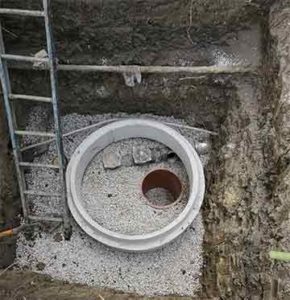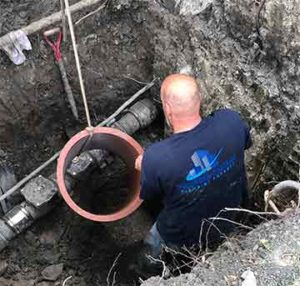A flood control system is a failsafe system that protects your home from sewer backups. It is often installed as a replacement for the standard backwater valve flood control system after that system fails. The way a flood control system is built gives it the ability to withstand conditions that would typically result in the failure of a standard backwater valve flood control system.
The regular backflow valve installed in most homes consists of:
- An in-line check valve opens to allow sewage flow from the house to the city sewer line. This valve closes when there is a storm and pressure builds in the city sewer system. The closed valve keeps sewage that is from the stormwater from flowing backward into the house.
- A pumping system consisting of an ejector basin and pump. When the in-line valve is closed, sewage can still flow from the house into the city sewer system because of the pumping system. Sewage from the home is diverted into the ejector basin and then pumped over and beyond the in-line check valve, to be pushed into the city sewer.
But sometimes this entire system can fail. This happens when there is so much pressure built up against the in-line check valve that it fails. Sewage under pressure from stormwater can blow off the lid on the in-line check valve and dislodge the check valve. Once this happens, sewage is free to flow unimpeded into the home.
What is a flood control system?
The flood control system is also referred to as a double-guard system because it consists of two check valves positioned in series. Also, instead of PVC, it has cast iron housing and brass check valves, with a lid that is bolted in place rather than screwed down. This system offers a more reliable way to protect your home from sewer backups during a storm.
Because the flood control system is made of cast iron and brass, it can withstand more pressure than a PVC system so, the likelihood of system failure is almost zero. Additionally, the presence of two check valves means if the first valve fails, the second one can still protect your home. Thirdly, the possibility of the check valve lid blowing off is nil because the lid is bolted down, instead of being screwed down.
How to install a flood control system
To install a flood control system, you have to remove the entire backwater valve flood control system in your home (except for the pumping system, ejector basin, and pump) and replace it with the flood control system. Note that this is not a project you should try to do yourself, it should be left to a flood control installation specialist or professional plumber.
Here are the steps for doing that:
Step #1
Excavate the area around the existing backwater-valve flood control system so you can go in and take out the entire system. This requires some demolition work to remove the circular blocks that make up the sides of the pit. The floor of the pit must also be removed to expose the pipes installed underneath.
Step #2
Move the incoming water line out of the way to keep it from getting damaged. Now remove the failed PVC system from the pit after you have loosened the flexible rubber couplings that hold it in place. This is the part of the system you want to replace.
Step #3
After this, install the new cast-iron twin-check-valve system and secure the connections at each end with flexible rubber couplings.
Step #4
Once the valve is securely in place, pour bags of ready-mix concrete around the valve with emphasis on both ends of the valve. Pay particular attention to the front connection and make sure it has enough concrete. This is the most important joint since it is the part that will take the direct pressure of the city sewer system.
Step #5
After this is done, pour a layer of gravel aggregate over the entire assembly and spread it over the concrete. This will help to strengthen the base around your newly installed system. Add water to the aggregate until it is soaked.
Step #6
Next, cover everything with a thick layer of sand to create the bottom of the pit. Once this step is done you are now ready to start laying the curved blocks that will form the circular walls of the pit. Keep laying the blocks until the walls is up to the surrounding grade and then top it off with an access cover.
Why do you need a flood control system?
If the region where you live is prone to natural floods, a flood control system can save you from anxiety, plus the cost of fixing flood-inflicted damage to your home, says Avalon Property Management. You may also need a flood control system to serve as a backup in case of sump pump failure. Regardless of where you live, a flood control system can add a second layer of protection to shield your home from flooding.

